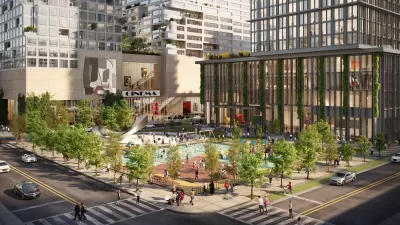Despite its plaint and utilitarian exterior, Astorians knew they had something special in a former military building containing a large open interior free of support columns space with a domed lamella ceiling. Now, it's a center of the community.
Can-do Astoria, a town of less than 10,000 people at the mouth of the Columbia River in Oregon, has accomplished civic feats that cities of over a million have been unable to accomplish. These include building a three-mile trolley line along its riverfront, recovering and restoring a 100-year-old river-crossing ferry, and restoring and putting back in use a vintage WWII-era armory building.
This article is about the armory. It had become a tattered warehouse for Astoria's Maritime Museum, but in its heyday, it was the social and entertainment hub for military personnel stationed in Astoria. Astorians have become accustomed to taking on out-sized projects—given the city's small population. With the help of Craft 3, a community development financial institution (CDFI), they acquired and restored the armory. Now it serves as a community center for the town, hosting 175 events per year. Michele Reeves, a Pacific Northwest "urban strategist" specializing in revitalizing commercial districts, toured the building. Her photos and observations can be found in full at UrbDeZine.
FULL STORY: Oh the Stories They Could Tell…Astoria Armory Edition

Planetizen Federal Action Tracker
A weekly monitor of how Trump’s orders and actions are impacting planners and planning in America.

Congressman Proposes Bill to Rename DC Metro “Trump Train”
The Make Autorail Great Again Act would withhold federal funding to the system until the Washington Metropolitan Area Transit Authority (WMATA), rebrands as the Washington Metropolitan Authority for Greater Access (WMAGA).

DARTSpace Platform Streamlines Dallas TOD Application Process
The Dallas transit agency hopes a shorter permitting timeline will boost transit-oriented development around rail stations.

Five Key Transportation Funding Proposals in Trump’s Budget
The President’s proposed 2026 budget would keep spending roughly the same for transit and rail and eliminate over $5 billion in funding for EV charging infrastructure.

LA County Creating Action Plan to Tackle Extreme Heat
Los Angeles County is creating a Heat Action Plan to help communities stay safe during extreme heat, with steps like adding more shade, improving buildings, and supporting the neighborhoods most at risk.

Maryland Plans Quick-Build Complete Streets Projects
The state will use low-cost interventions to improve road safety in five Maryland counties.
Urban Design for Planners 1: Software Tools
This six-course series explores essential urban design concepts using open source software and equips planners with the tools they need to participate fully in the urban design process.
Planning for Universal Design
Learn the tools for implementing Universal Design in planning regulations.
City of Charlotte
Municipality of Princeton
Roanoke Valley-Alleghany Regional Commission
City of Camden Redevelopment Agency
City of Astoria
Transportation Research & Education Center (TREC) at Portland State University
US High Speed Rail Association
City of Camden Redevelopment Agency
Municipality of Princeton (NJ)



























